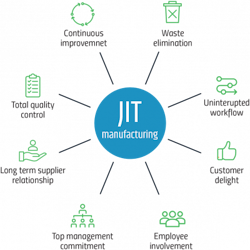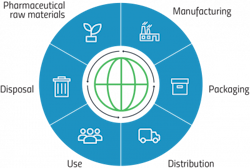Mounting concerns around sustainability within the pharmaceutical industry have driven the need for — and adoption of — green chemistry over recent years.
Green chemistry refers to the design, development and manufacture of chemical products using efficient processes that reduce the resources required, minimize waste and eliminate the use or generation of hazardous substances.
This push has resulted in more environmentally sustainable practices and technology throughout the drug development process. For example, drug substance manufacturers have been challenged to make their traditional chemical processes greener through better exploitation of catalysis (including biocatalysis), sensible solvent usage and intelligent choice of starting materials and reagents.
However, even with the greening of some parts of the manufacturing supply chain, the existing linear model is not efficient or sustainable. To transform the industry into one that is both innovative and resource efficient, a more holistic approach is needed across the multiple dimensions of the drug development process. A move towards a circular economy, which aims to maximize treatment value and facilitate greater sustainability within the supply chain, may offer a systemic approach to addressing these needs.
The greening of pharma
Successful integration of green chemistry principles has undoubtedly led to more economically viable and environmentally sustainable means of turning molecules into medicines.
Green chemistry follows several “design rules” to help chemists achieve sustainability. At Elsevier’s 2nd Green and Sustainable Chemistry Conference, five key areas were identified by industry leaders as critical to inspiring a more sustainable industry. Green chemistry:
- Needs to anticipate the problems it aims to solve. For example, aligning industry efforts with initiatives such as the United Nations’ Sustainable Development Goals requires chemistry that addresses regulatory challenges coming down the pipeline.
- Should not aim to justify negative perceptions of other elements of chemistry. It should instead focus on how to build upon innovation and position itself as the next progressive step.
- Should aim to break down the green chemistry silo. The industry needs to consider how a product works in the context of the customer, as customers ultimately drive business growth.
- Requires the integration of circular economy in the product life cycle. Chemical innovation is a cross-disciplinary effort and collaborating to create sustainable products is a great opportunity to promote the positives of better chemistry at the heart of cutting-edge materials technology.
- Requires an informed public, with a clear demonstration of the value of safe, sustainable chemistry. Ensuring that the public understands why a product is more sustainable than its alternatives, and what this means practically for the consumer, environment and industry.
Within drug substance development, technologies to support more sustainable and greener processing have already become popular alternatives to traditional methods. Biocatalysis, for example, offers opportunities to use or generate less hazardous materials and operate more energy-efficient processes. It contributes to an environmentally friendly industrial toolbox for drug manufacturing that can complement and improve the classical chemical synthesis in the production of pharmaceuticals — for example by replacing toxic reagents — and it can also be highly efficient and economical.
The introduction of flow chemistry, particularly in drug discovery and early stages of drug development, has also enabled the exploitation of greener reactions with far higher efficiency and less waste. Flow photochemistry has an advantage over batch processing, namely a better, more uniform irradiation gives each molecule a more consistent processing experience. This results in far cleaner and more selective reactions, permitting significant efficiency gains and a potentially more straightforward scale-up.
Continuous manufacturing of drug products also has demonstrated benefits according to the principles of green processing, including better efficiency and minimized waste, as well as improved safety, quality and costs.
Circular economy – a more holistic approach
To achieve true sustainability, a more holistic approach to overall drug development is needed. This should be implemented via processing and operational excellence not just in manufacturing, but also across R&D, materials sourcing, supply chain connectivity and waste management at the later stages of the product life cycle.
JIT manufacturing is a process for achieving continuous improvement through the systematic elimination of waste and encompasses not only production control techniques, but also total quality control programs, facility and line design, employee training, etc.
Flexibility and agility, alongside six sigma, lean and just-in-time practices, for example, are required across the entire pharma supply chain. This includes raw material, intermediate, drug substance and drug product manufacturing, devices and packaging, extending to the production and utilization of materials and components of manufacturing equipment, and on to warehousing and distribution.
As referenced in the fourth green chemistry principle, implementing a circular economy will support a more holistic greening of the overall drug development process, accelerating the move towards a more sustainable and efficient industry.
Transition towards a more circular economy will dictate changes throughout value chains, from materials and product design, manufacturing and supply, to new business and market models. New ways of minimizing waste and turning waste into resources, prolonging the stability of products and changes to patient behavior, are also important considerations.
Effective waste management
An example of the circular economy in practice can be seen in closed-loop supply chains, in which suppliers, manufacturers and recyclers collaborate and work closely to increase resource and cost savings.
An increase in patients, prescriptions and overproduction of some medicines, for instance, has contributed to higher volumes of pharmaceutical waste as well as increased disposal costs. It is a growing concern globally that requires a systemic approach to its resolution, and an area where a closed-loop supply chain could be of huge benefit.
Of course, avoiding waste is the ideal scenario, and the growing efficiency of chemical reactions and manufacturing processes continues to impress despite the greater technical challenges that are presented to drugmakers tasked with delivering the next generation of therapeutics. Turning waste into secondary raw materials within the pharmaceutical industry could minimize the environmental impact of its activities across the entire value chain while also reducing costs in the long run.
In the truly circular economy, waste from one process would be the input for another. Of course, the stringent regulatory framework makes this a substantial challenge for the pharma industry, but progress here has been made with the judicious use of solvents. Circular systems employ reuse, refurbishment, remanufacturing and recycling to create closed-loop systems by embedding circular principles in the design phase and by minimizing the use of resources and the creation of waste, pollution and carbon emissions.
This approach should be encouraged widely across the industry, especially for solvents, devices and packaging. In the design phase, choosing sustainable, renewable or recycled materials to preserve resources, lessen the environmental impact and maximize product lifetimes should be an integral part of the thinking.
Devices will be replaced with more environmentally friendly alternatives to significantly reduce carbon footprints where possible. For example, a shift to using dry powder inhalers (DPIs) in place of pressurized metered-dose inhalers (pMDIs), which have a carbon footprint 10-37 times higher than DPIs, would reduce carbon dioxide emissions by 58 kilotons in the UK alone.
Although environmental concerns are important to consider for long-term sustainability in the pharmaceutical sector, patient experience must remain the primary objective. A move towards DPIs should be made, but other methods such as life cycle assessments to identify other areas of improvement for DPI production and use, and effective recycling should be considered where direct replacements with pMDIs might not be effective for all patients.
A move towards recyclable packaging will be beneficial and should be at the forefront of the design and manufacture of new packaging solutions. For instance, a recyclable version of the innovative Push Pack — the blister packaging that is the most popular method of medicine storage but often made using non-recyclable PVC — is expected to be on the market by 2022 should the validation process be successful. However, no rules exist that enforce the use of sustainable packaging amongst pharmaceutical companies and the final decision is left with the manufacturers.
Within the pharmaceutical industry, a circular economy aims to promote waste reduction, maximize medicines' value, and enable sustainability throughout the entire supply chain.
In 2020, industry surveys revealed that 48% of biopharma manufacturers always look for packaging that is recyclable or that can easily enter the waste stream, and 81% are likely to use energy-efficient packaging in the near future.
The key to overcoming the sustainability challenge from a packaging perspective is to take patient needs into consideration from the start. For example, combination products that include a drug and medical device together represent another approach receiving growing attention in terms of improving environmental impact. For drug manufacturers, actively seeking greener ingredients and technologies and communicating this to patients can have a big impact. But patient views should always be considered and will be a key driver of sustainability in this area.
Implementing sustainability
To achieve sustainability across the supply chain, the ability to rapidly integrate innovation and emerging science is key. New environmentally and economically efficient processes and technology that can advance the goals of green chemistry continue to emerge, but replacing existing methods with greener chemicals, materials and process technologies and implementing a more circular model at an industrial scale can be challenging. The complexity of the chemical supply chain requires development and commercialization partnerships for new technologies to become optimized, scaled and driven into products and onto pharmacy shelves.
Integration of greener and more circular processes and technologies can be expedited by partnerships and better collaborations across drug substance and drug product development, as well as suppliers, manufacturers and recyclers. Collaborating with a dedicated innovation partner that specializes in developing economically and environmentally sustainable pharma manufacturing processes, for example, can provide process chemistry solutions to support the delivery of best-in-class small molecule therapeutics while reducing environmental impact. An increase in collaborations amongst pharma companies and across other industries to enable tech transfer and sharing of ideas and new processes or materials will also be beneficial.
Six sigma methodology involves the identification, recognition and definition of problems faced in the drug production process, as well as the characterization, measurement and analysis of data to identify weaknesses. This optimizes quality control systems, increasing production and innovation and reducing cycle times.
Genuine circularity strategies for pharmaceuticals are not routinely explored in many countries, but top-down approaches can also help achieve widespread and effective implementation of more holistic green chemistry technologies and processes. In Europe, for instance, a circular economy is a key policy pursued by the European Commission. One of the four key pillars underlying the European Commission’s Pharmaceutical Strategy for Europe details “supporting competitiveness, innovation and sustainability of the EU’s pharmaceutical industry and the development of high quality, safe, effective and greener medicines.”
New regulations will have a knock-on impact on the driving industry to become more efficient, forcing a transition to green approaches and more streamlined and efficient technologies. Accordingly, if enforced sufficiently, these regulations can drive the discovery and deployment of new and innovative processes for drug development that guarantee the health and safety of employees and patients while also reducing the environmental impact of the industry.
On a more localized level, investing to improve and maintain infrastructures such as modern manufacturing facilities, recycling schemes and effective waste management will also contribute to improved sustainability.
Shaping the future of pharma
Implementing a holistic approach that integrates green chemistry across all amenable activities within the drug development and manufacturing supply chain and full life cycle of a pharmaceutical product is essential to achieve sustainability.
A circular economy represents a sustainable supply chain proposition. By integrating this approach across several key areas — including raw materials and waste management, drug manufacturing (substance and product), devices and packaging — there is an opportunity to shape the future of the pharmaceutical sector. As well as provoking more efficient use of resources and processes and better sustainability, the implementation of a circular economy could also help to drive innovation and improve long-term economic value.
Furthermore, more agile and flexible manufacturing will also help support a new focus on more localized production solutions, thus reducing the environmental burden of shipping and storage.
Making more responsible choices, increasing expenditure on new, greener technologies, forming strategic partnerships (including cross-industry collaboration) and new regulations that support innovation and environmentally friendly processes while also improving efficiencies will be key to success.







